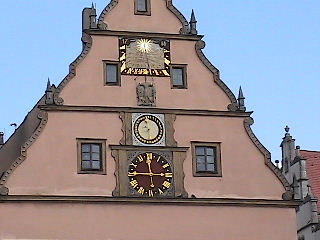
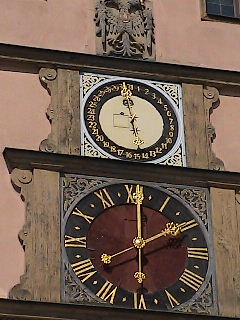
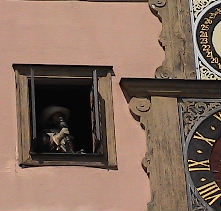
Note that this clock has a sundial and a calendar mechanism. In medieval times a sundial was the only way to set the clock! This clock also memorializes a legend. The gentleman depicted in the window is said to have saved the city by winning a bet with the general of an invading army that he could drain a large vessel of the local brew in a single swallow.

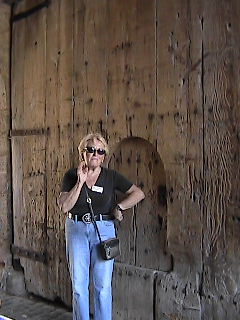
As in all the old towns, there were the defensive walls, and in all the walls there were gates, and all the gates seemed to be built into towers. This acounts for the confusing similarity of the German words: turm - tower; tor - gate; and tür - door. On the left is the Burgtor of Rothenburg.
On the right, our guide explains that the gates usually had a "man hole" within the main door. This was used to let someone in after the main gate had been closed for the night. A large fine accompanied the operation though, so we speculated that not a few laggards chose to spend the night in the open.
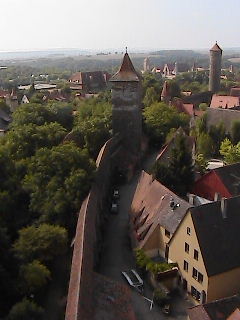
Climbing another gate-tower, the Rödertor gives one views like this.
Here is a most interesting tale from the recent history of Rothenburg. Some of it is quoted directly from the Night Watchman's booklet and some from memory of his oral presentation.
On Easter,1945, a German general and his troops left battered Nurnberg for Rothenburg and joined some Nazi soldiers who were already stationed here. The general gave the order that the town should be defended to the last man. Two days later, on March 31st, 16 planes dropped their bombs on Rothenburg. The bombing of the town killed 39 people and destroyed 306 houses, six public buildings,nine of the town's ancient towers and more than 2,000 feet of the historic wall. War had returned with a vengeance to this fortified city.
But unlike 300 years ago, the city was saved by warriors who could see into the future. U.S. Deputy Secretary of State, General John McCloy, who was familiar with the historic importance and beauty of Rothenburg, sent word through the local commander, U.S. Army General Jacob L. Devers, that the city would be spared further bombing if the citizens could guarantee that it would not be used as a base for further resistance. With the war all but over, the citizens agreed, but there was still the German general's order to "defend to the last man". By a fortunate turn of events, that general was away from Rothenburg when the decision was to be made. The temporary commander took his life in his hands by surrendering in sympathy with the motives of General McCloy and the town was spared.
The German troops surrendered on the 17th of April and a few hours later, the city was again occupied by foreign troops--this time troops bearing the American flag. General John McCloy was awarded the "Honorable Protectorate of Rothenburg" in November, 1948.